     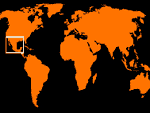  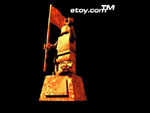    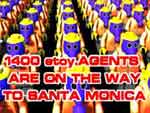         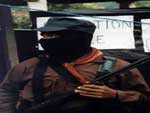  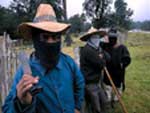   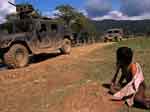     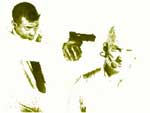 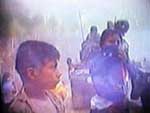 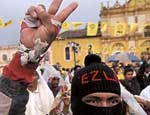       
|
background.txt
this is a study of two social groups that we see as structurally similar.
one is the ejercito zapatista liberacion nacional, the indigenous guerilla
army of chiapas, mexico, who incorporate international efforts into
their work to build recognition within their own country. the other
is etoy, the internet-based art collaborative that is also seeking to
build name recognition in its efforts to infuse the "boring media art
world" with unconventional actions. the zapatistas, years in the making,
gained national attention by forcefully occupying the city of san cristobal
de las casas on january 1, 1994. etoy also gained notoriety in 1994
through their digital highjack of millions of interfaces throughout
the globe. both groups are angered by the status quo and see a numbing
affect on a far-reaching and diverse audience. this audience, whether
communicating through a political vote or through electronic media,
has experienced a loss of voice as well as continued segregation into
smaller and smaller entities. etoy and zapatismo seek to re-unify an
increasingly isolated culture through radical movements that transcend
the existing bureaucratic structures. in this way, they are innovative
rebellions that seek not to overthrow a single person in power, but
rather to accomplish a more difficult task of changing society from
the bottom up. the zapatistas do so on a political level; etoy on an
artistic level.
the zapatista islands are their five occupied territories within the
state of chiapas. etoy's island is sealand, a small, artificial structure
in the english channel where their server is located. our project focuses
on the parallel means that they use to transcend the island boundaries
and communicate on a global scale. these include the internet, the media,
art, and cultural symbolism.
these means are the main weapons for the groups. both have earned their
guerilla identity through actions in resistance, against the economic
conglomerations of the international monetary fund, the world bank,
neoliberalism (zapatistas), or against etoys.com, on of the largest
e-commerce corporations and an "old-fashioned corporate bulldozing power"
(etoy). they are guerillas because they are clandestine and separated
from the population, even as they win over converts and support outside
the rank-and-file, and because they use tactics from the outside. their
strategies - international encuentros, art projects, and web networks
-- do not yet exist in their enemies' arsenal. the word domain refers
to both their use of websites and the territories which they have constructed
in order to occupy them. these are island spaces with their boundaries
drawn on land, in cyberspace, by social exclusion, and by the english
channel.
http://www.etoy.com
http://www.ezln.org
coexistent scales.txt
while the zapatistas started in a geographic island location (the 5
aguascalientes) and in a social island (the guerilla structure of hiding
in the jungle, unable to sustain interaction with the population at
large) and moved onto the internet, etoy began to incorporate itself
on the internet. it is only within the last year that etoy has sought
a permanent physical situation on the principality of sealand. the world's
smallest sovereign territory and a man-made island, sealand is now being
leased by havenco to various internet corporations as a safe shelter
for their servers. etoy is one of these corporations.
at this time a short history of sealand is necessary. during WWII, great
britain established an artificial island on the high seas. it served
as a military base to assault german aircraft. in the winter of 1966,
a british family took possession of the abandoned island. they hoisted
a flag and declared the existence of a new state - the principality
of sealand.
http://www.fruitsofthesea.demon.co.uk/sealand/index.html
thirty years later, after defending the integrity of their island through
both gunfire and passport control, the family decided to leave their
home. this made sealand available for other projects, and in early 2000
the royal family leased sealand exclusively to havenco for its datacenter
operations.
the zapatista territories are land islands. there are several conditions
which must be met to achieve international recognition as a guerrilla
movement, and one of them is occupation of land. the zapatistas maintain
five occupied areas, although the indians that support and participate
in their actions live in a broader space. these "bases" are located
throughout the state of chiapas: roberto barrios, la realidad, oventic,
morelia, and guadalupe tepayac. each one contains bunkhouses, a stage,
a meeting house, and other buildings which are services for the zapatista
population (not only for the army, which is always shifting in size),
but are usually not permanently occupied. one exception is the schoolhouse
in oventic, which houses 20 teachers and some two hundred students.
it is important to note that, although these are called the army bases,
weapons of any kind are forbidden. instead, they serve as communication
centers. if the indians hold a meeting, a vote, a convention, or a party,
they will use this center. collectively, these islands are called "aguascalientes."
this name refers to the city north of chiapas where the mexican constitution
was ratified by the national heroes emiliano zapata and pancho villa,
the leaders of the mexican revolution in the early 1900s.
the guerilla structure of the movement also makes an island from social
isolation. it is possible to visit the surrounding area and not hear
any mention of the conflict. there are definate signs: graffitti on
the city walls, handcrafted zapatista dolls for sale in the market,
and military police throughout the area, but a tourist could easily
come into the area and not put these clues together. guidebooks in the
past couple of years do not even mention the uprising. many of the residents
also continue to live their lives without involving themselves in the
conflict.
both etoy and the zapatistas fight for a virtual place on the internet.
the zapatistas have to contend with fake websites, some of them by government
agents seeking to dispel the guerilla army's rising popularity, and
some by accident.
http://www.zapatista.com
http://www.ezln.com - the latter is a laundromat in conneticut!
the zapatista presence on the web has been as essential to their identity
formation as the physical territories that they occupy. on both geographic
and virtual scales, place serves to construct identity. etoy has also
had to fight for their virtual identity. they formed their corporation
in 1994 and have held the domain name etoy.com since then. an american
company formed in 1996 chose the name etoys.com, and later sued etoy.com
because the similarity of the names was preventing customers from reaching
the site. the litigation was succesful, however, etoy responded by inititiating
what is now know as TOYWAR. etoy agents sent emails to supportive friends,
who in turn circulated the message to other companies, resulting in
a press frenzy. the next day the story of the poor, artisitc movement
bulldozed by the big nasty american company was broadcasted across the
international press. etoy supporters attaced the etoys.com website with
connections that overloaded its servers, causing it to malfunction for
short periods of time during the christmas rush. etoys.com stock dropped
from $67 to $15, and they dropped their lawsuit.
***this made toywar the most expensive performance in art history: $4.5
billion in damage! a glorious victory for the etoy.corporation which
rewarded the activists that helped it with etoy.shares. in march of
2000 the newly-named etoy.soldiers became etoy.co-owners with voting
rights.***
the war was held purely through the internet; a virtual war for a virtual
place. however, it affected real lives and a real company. etoy has
also created etoy.tanks: large orange boxes, similar in shape to the
standardized containers used for freight shipment. the etoy.tank functions
as a movable art office and can be shipped by helicopter or boat throughout
the world. the tank, possibly carrying an agent or some other ammunition
for the etoy.corporation, mimics the contained information package of
electronic data.
globalization.txt
both etoy and zapatista are reactions to globalized phenomena, but they
are not solely retaliations against globalization. they accept globalization
and incorporate its structures into their own. however, they seek to
use and promulgate the anarchistic and non-hierarchical aspects of globalization,
in order to decrease the ability of major powers to control information.
through experience with the zapatistas, an international population
becomes aware not only of the maya history and culture, but also their
ancient structure of consensual democracy. many of the international
volunteers who visit the area seek to understand a variation on modern
hierarchical and often exclusionary democracies that considers and equalizes
all individuals. (this is highly relevant in the wake of efforts in
planning to use bottom-up social structures, empower populations, and
involve a large citizen body in the planning process. most efforts from
the developed world to do so have been unsuccessful.) presence on the
internet strengthens the maya culture and attracts participants seeking
to learn from the population.
among the obvious differences between the two (the one is political,
the other artistic), one of the most severe lies in their treatment
of and attitude towards the financial market. the zapatistas fully oppose
the financial structure of global capital. they sought to attack the
market from the top down: aiming their rhetoric at the international
monetary fund, the world bank, NAFTA and the mexican and american governments,
and the forces of neoliberalism. in some ways they were actually able
to make a tangible impact. former mexican president carlos salinas de
gortari had his campaign to become the next head of the world bank damaged
by the uprising, which occured in his term of office. secondly, companies
became reluctant to invest in southern mexico because they feared political
instability. influence on the global demonstrations against neoliberalism
that followed is a third possibility, but it cannot be measured.
etoy's affect on the stock market is more direct and more visible. their
attack on etoys.com originally began as a defense of the name, but etoy
quickly assimilated the result into their identity. their official initial
public offering started nearly two years earilier in austria, in january
of 1998. etoy had already existed on the stock market before the toywar,
and used shares in the company as rewards for aid in the toywar. the
shares represent the only art product made by etoy. "etoy is the value.
the share is the art product." they claim that this product does not
follow the rules of ordinary finacial markets. there is no product or
service for sale. the shares are a product inasmuch as they can be bought,
but they are also called art. therefore etoy made global finance part
of its adventure, while the zapatistas shunned it.
the etoy hijack interfered with servers all over the world. 200,000
hostages were hijacked in the first few months alone of the project,
with over 1,000,000 to follow. the "hostages" were innocent web surfers
using search engines. if they entered certain words (fassbinder, censorship,
porsche, starttrek, bondage, selbstmord, etc.) they were taken to the
"don't fucking move! you've been hijacked! webpage. for those interested,
it is possible to still be voluntarily hijacked for recreational purposes.
http://www.hijack.org
many international newspapers covered the digital hijack story.
our groups act through the internet and their information is accessible
worldwide, but in reality, only a small audience experiences direct
contact. as with their clandestine geographic locations, it is possible
to come very close to the networks without being conscious of their
existence. globalization does not mean that everyone is experiencing
the same thing; only that it is possible to reach across spatial or
other boundaries and recieve information. there are zapatista groups
working in new york and in japan. last month, it was also possible to
hear two zapatistas speak in kulturhuset, stockholm center. and, there
are links to zapatista sites directly from the etoy pages.
surveillance.txt
surveillance: the eye that is on the two groups
surveying: the eyes of the groups on the outside world, and the opinions
they form that are the base for the actions
both groups began by holding meetings in secrecy. the zapatistas started
training in the lacandon rainforest in 1983 and did not emerge on the
world scene until they forcefully conquered the city of san cristobal
de las casas, on january 1, 1994. this date coincided with the beginning
of the NAFTA treaty. etoy began meeting in secret in 1992, first in
the swiss alps and later in various decripit hotels in eastern europe.
thier first appearance was also in 1994, at the ppp-fetischismo party
in basel, an area heavily laden with pharmaceutical industries. 1994
is also the year that the internet went public. although both groups
continue to meet in secrecy and protect the identities of their agents,
they now live in a zwiespaeltig (the word means split between two sides)
situation of also trying to market themselves and subject themselves
to the international surveillance of the media.
originally,they were surveying global structures. etoy was looking at
media art and the waves of banality surfing the internet. the zapatistas
were looking at the false front of democracy in mexico, where a singly
party had used corrupt methods to stay in power for 70 years, and at
a democratic system that was putting an economic stranglehold on their
lifestyle. they took it upon themselves to be the watchdogs of these
structures and to broadcast to the world the nature of what they saw,
posing themselves as experts. many people were convinced; many were
already in agreement before they began. but once etoy and the zapatistas
began to have a presence and state opinions, they opened themselves
up for surveillance from their audience.
in presenting themselves for the surveillance of those who decide to
look at them, they carefully choose certain images to present. nobody
sees their identity as people; only the constructed image of the group
is available for interpretation. etoy agents show up wearing bright
orange jackets in a high-tech, futuristic uniform. they seem to want
to look like they come out of a virtual world. zapatistas are filmed
dramatically riding on horseback, and always wear masks. etoy wears
sunglasses. these trappings imply anonymity, even as the group attempts
to reach a wide audience. protection of the individual identities is
a premium. zapatistas revealing their true identity risk incarceration
or paramilitary attack. if etoy agents revealed their identity, the
concept of their art project without individual creators would be destroyed,
as would their revolutionary art movement. the usefulness of the mask
to hide personal identity grew into a symbol of identity: another example
of zwiespaeltig.
etoy agents do not risk their lives, but they do want to avoid personal
surveillance or incarceration. both groups have merited CIA investigations.
CIA investigations on etoy started with house searches in vienna in
june 1996, for net crime and digital terrorism. this was a newly-created
branch of the CIA. however, special agent korrinek from the austrian
police could not understand why etoy was digital hijacking and offering
anonymous email services - no wonder: he didn't even have a computer!
etoy ended the investigation by sending 7 kilograms of printed log files
(signifying nothing) to the department. the anonymous email service
is also relevant as a way of escaping surveillance.
we were unable to find information on etoy's actions within the past
year. we do not think that this is because etoy has ceased operations,
but rather because of their need to keep their plans free from surveillance
until the action is completed. only at this point can it go on the electronic
historical record. the zapatistas are under a very bizarre system of
surveillance. they are not like the FARC, the revolutionary guerilla
movement in colombia, who use tactics that foreign governments can portray
as against international interest: frequent armed attacks, kidnappings,
and using profits from the drug trade to finace their movement.
the zapatistas are under a very critical public relations eye. they
do not have the weapons or numbers to defend themselves against an armed
attack, although they have had, sporadically, enough numbers to peacefully
take over towns and evict armed policemen. the aguascalientes have a
tentative existence subject to the constant reminder of the mexican
government's presence: helicopter and airplane fly-bys, military checkpoints
on roads leading to the areas, and the occasional raid. however, the
zapatistas are dependent on global attention for their survival. without
the watchful protection of several dozen human rights groups, the united
nations, and individual volunteers, indigenous mexicans who support
the zapatistas are much more susceptible to paramilitary attack, raids,
and death. the consistent broadcasting of every infraction against their
freedom keeps the movement alive and protects it. knowing this, anti-zapatistas
have tried to undermine their support by portraying them as irrational,
debasing as inauthentic subcomandante marcos, their most skilled spokesperson,
and ignoring the causes of their insurgency. the war is very much a
public relations war with the mexican government, forcing the guerillas
to rely heavily on their international recognition and their voice to
defend themselves. one advantage of this is that both sides can win
a public relations war through negotiations and aid to the chiapaneco
peasants.
adapted technologies.txt
"waiting is dying, survival means changing" is a quote from the etoy
webpages. this quote demonstrates both groups' need to keep at the forefront
of new technology. their recognition in the international scene depends
on it: they are only two of numerous guerilla and underground groups
fighting for attention in a unending information flow. it is striking
that regardless of how powerful their causes are, the movement boils
down to strategic marketing and mördande rekam (killer advertisements)
to get the point across.
the internet phenomena creates a global arena for small enclosed entities
whose survival depends (to some extent) on their successful and continuous
manipulation of the new landscape. in their earlier years, etoy coordinated
light and music shows for rave parties: a musical culture adapted to
new technologies. while music is still an important part of what they
are doing, their emphasis has shifted from parties to corporate structures
and network identities. neither their intent to challenge fixed structures
nor their infatuation with new chemical compounds has decreased. coming
from mexico, the substitution of a media terrain for a physical one
lessens the need for weapons and armed conflict. in the virtual battlefield
- internet, literature, and press -- the zapatistas wear more bullets
than they shoot.
a cultural victory in this media depends on how the groups have been,
or have chosen to be, portrayed to the outside world. wearing bullets
is important for photo opportunities. the picture of marcos with his
pipe is frequently referred to in romantic terms. the etoy figures and
the zapatista soldiers tap into our existing mental images of freedom
fighters (drawing from both comic and political imagery) and allows
them immediate access to global good will. the symbol is as efficient
a means of communication as the email.
the accessibility of new technology to masses of people has resulted
in its appropriation for guerilla uses. anarchistic demonstrations are
formed through frequent calls on cellular phones coordinating large
crowds. but communication is not the only purpose. new technologies
are also being used to archive, record histories, and construct and
preserve symbolic cultural meaning. subcommandante marcos' communiques,
near-monthly letters distributed to select groups and on the internet,
are consistently grounded in the symbolic language of the maya culture.
he calls the increasing voices of the indigenous zapatista the wind
emerging from the mountains of the mexican southeast, and adds the voices
of dead ancestors to that wind. in this way, he powers his words with
thousands of years of history. this is not, however, for legitimizing
effect, but because the foremost goal of the ezln is to gain recognition
for the integrity of the indigenous people of chiapas.
the need to constantly project a specific character to media is heightened
by the defragmentation effect of new technologies. the end result of
these images is distorted and out of context on the internet. however,
the narrative breakdown encourages audiences to seek out more information,
and allows them to construct their own perspective on different issues.
|















































































